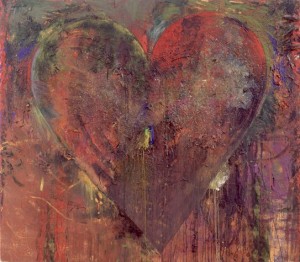It’s about the paint
In the most recent Art in America, the editors called out a quote from Ed Ruscha about painting which has been nagging at me: “I’m still puzzled about my own work when it comes to painting—whether it’s really that necessary to believe in this great ideal of the painter’s painter and the idea of spreading paint on a canvas. I question all of that.” Ruscha’s work as a pure painter can be tremendously impressive, the simplicity and scale of his imagery, so stripped of emotion and seemingly devoid of context—his imagery is monumental, impersonal, and mysterious in a cerebral but fascinating way. One might almost say Cartesian in the way each painting seems absolutely sure of one thing: its own existence. When he superimposes text—his little Zen koans that aren’t meant to enlighten—the mysteries thin out toward a supercool ambiguity, like lines out of John Ashbery, so resonant when you read them until they self-destruct when you try to investigate a little further. Nothing wrong with that, but puzzlement gets old when awe doesn’t make you forget about trying to understand what you’re seeing. And Ruscha’s word paintings are too intentionally sardonic to evoke awe. They have Pop’s detached, self-cancelling reserve, suggesting a skeptical perspective on popular culture without ever letting you in on the joke. Ruscha’s precision, the way he makes you forget you’re looking at paint is part of what gives his huge paintings, the wordless ones, so much power, so it’s understandable he might decide to dispense with paint altogether.
The fascination of painting, first and foremost, is the sheer physicality of paint. Many of the greatest paintings revel in their ability to rub your nose in the nature of the medium on a given surface, the way it slides, clumps, and flows, thick as icing on a cake or thin as wax on a car—all of this while the paint makes you imagine something else, even if it’s as indistinct as a Rothko horizon line. This double-vision—the way a painting can make you see paint qua paint, while, at the same time, evoking an illusion of something that isn’t really there—that’s the magic. When Ruscha makes the paint irrelevant, when he makes you see only what he means for you to see and forget what you’re actually looking at, then he might as well dispense with paint. And that’s a perfectly acceptable choice. Spreading paint is simply a choice, but a choice that points toward a sort of surrender you don’t find in Ruscha’s work—a surrender to the medium where it’s allowed to contribute in ways that can’t be entirely controlled or anticipated. De Kooning made this surrender the central impetus of his work, yet go back centuries and you’ll see this duplicity, this fascination with the luxuriance of paint itself, as well as for the way it can let you see beyond it. It’s there, again and again, at the center of an artist’s mission, this duplicity. Bacon says somewhere, to comment on his indebtedness to Velasquez, that the texture of paint on a canvas—simply the way it’s handled—can have a direct, subconscious effect on the nervous system of someone who looks at the painting. That comment was his way of saluting the glories of brushwork in a typical Velasquez, and you can see how Bacon’s own handling of paint derives from it. Think of the artists whose discipline was to “push paint around” in his or her own unique way—a phrase Peter Schjeldahl used to describe Soutine’s technique. Braque, Van Gogh, Bacon, Freud, Sargent, Manet, Hals, Chardin, Vermeer, Matisse, Porter, Bonnard, de Kooning, Thiebaud, Sickert, Dine, El Greco, Saville, Kiefer, Innes—I’ll stop, but the list keeps going. Select a painting from each of those artists and turn it upside down—to nullify the image you’re meant to see through the paint—and just observe the surface, and it’s obvious how each artist imparted a unique feel for anyone viewing the canvas, simply in the way each applied paint to the surface. The texture produces a certain kind of purely physical experience. They all learned how to get paint to do things on its own and to make the almost tactile sensation of looking at paint a part of the mission. The list of artists who don’t do this—those whose genius emerged primarily in watercolor like Blake and Klee and Burchfield—might be just as long. But I think, to say the least, we’ve moved beyond the point where we think rendering an image in paint is the ultimate ideal for art, since we just emerged from a long dark period where painting was left for dead. Even so, it’s nice to hear somebody still talk about “the ideal of the painter’s painter.” If you want to be in total control of the process, of the final image, by all means, toss out the acrylic, the enamel, the oil, the brushes and knives and the rags. Yet the act of painting is as much about the body as it is about the mind. If you want a medium that has a life of its own, conveying the purely physical qualities of the object and the unexpected quirks imparted by the movements of fingers, hands, arms—and maybe even the legs, in the case of Pollock—then you can’t do any better than work in oil.

Comments are currently closed.